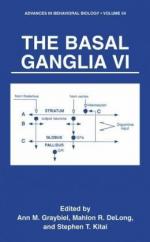|
This section contains 308 words (approx. 2 pages at 300 words per page) |
The basal ganglia has been recognized as an important area of the brain since the seventeenth century. Then, the English anatomist Thomas Willis published a description of the basal ganglia, although at that time it was referred to as the corpus striatum. This name reflected its striped appearance, due to fibers. It was a structure thought to receive all sensory input and which initiated all body movements.
The term basal ganglia means "basement structures." This reflects the location in the brain, deep beneath the cerebral cortex. Basal ganglia are comprised of so-called subcortical nuclei: the caudate, putamen, globus pallidus, nucleus accumbens, substantia nigra, and the subthalamic nucleus. Bearing out the earlier speculations, basal ganglia have an important role in regulating and coordinating movement.
The basal ganglia, along with the cerebellum, function to modify movement on an almost continuous basis. Outputs from the basal ganglia are inhibitory, while outputs from the cerebellum are excitatory. It is the balance between these two systems that produces the smooth and coordinated movement of an organism.
The caudate and putamen receive input from another part of the brain called the cerebral cortex. Some information is routed onward to the substantia nigra, which in turn communicates back to the caudate and putamen, and sends information to control head and eye motion. As a contributor to these functions, the substantia nigra produces dopamine, a chemical that is critical for normal body movement. Breakdown in dopamine production produces erratic and uncontrolled movement, as is seen in Parkinson's disease.
Information from the caudate and putamen is also routed to the globus pallidus, which in turn communicates in an inhibitory way with the thalamus. This inhibition of thalamus function is thought to be necessary for takes such as proper posture, where the activity of reflexes that would detract from upright control must be reduced.
|
This section contains 308 words (approx. 2 pages at 300 words per page) |


